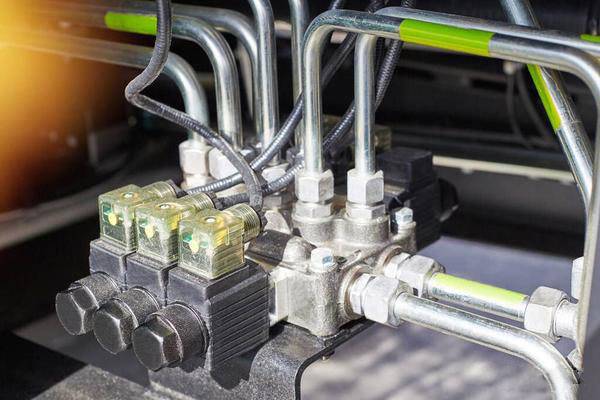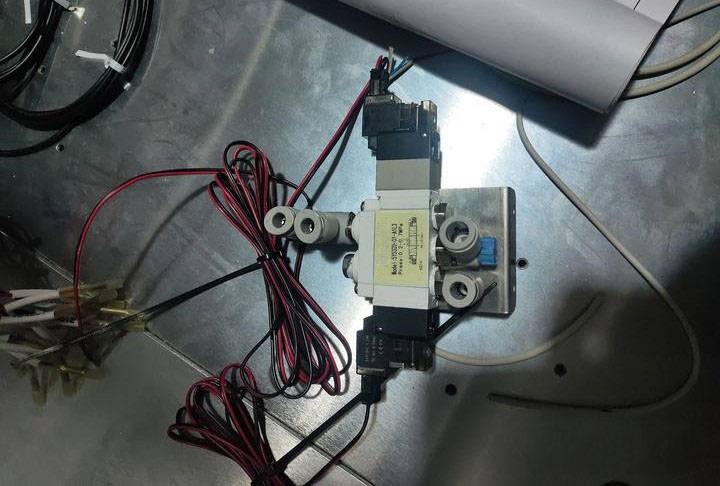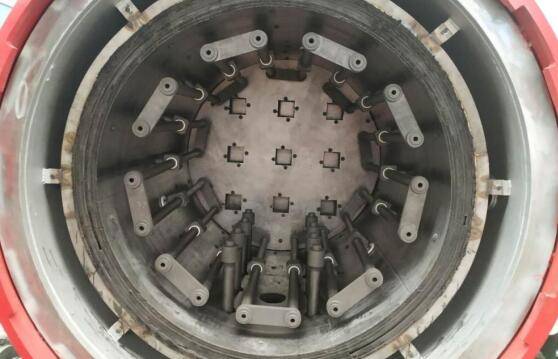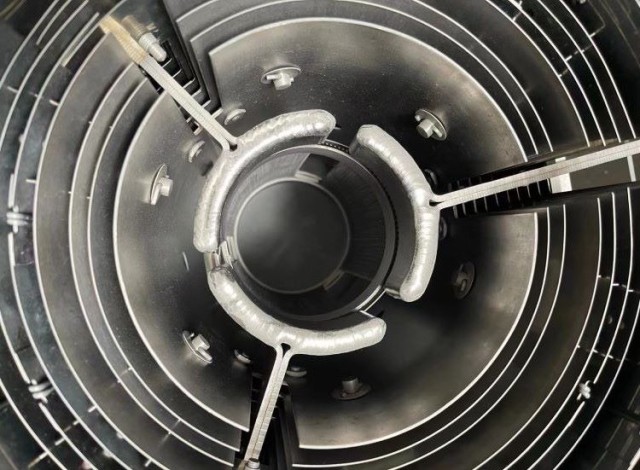Vacuum Issues
Low Vacuum
Low vacuum in a sintering furnace is primarily attributed to pump oil contamination, which can occur due to several factors such as the presence of impurities or degradation of the oil over time. Additionally, issues can arise from using too little or too thin pump oil, which fails to maintain the necessary viscosity and lubrication properties required for efficient vacuum pumping.
To address these problems, the vacuum pump must be thoroughly cleaned to remove any contaminants that may have accumulated. This process typically involves disassembling the pump, using appropriate cleaning agents, and ensuring all internal components are free from debris. Furthermore, it is crucial to replace the vacuum pump oil with a fresh supply that meets the specifications for the specific model and operating conditions.
| Issue | Cause | Solution |
|---|---|---|
| Low Vacuum | Pump oil pollution, insufficient or thin oil | Clean the vacuum pump, replace with new vacuum pump oil |
Ensuring the vacuum pump operates with clean and appropriate oil is essential for maintaining optimal vacuum levels, which is critical for the proper functioning of the sintering furnace.
Leaks
Leaks in a vacuum sintering furnace can be a significant issue, leading to suboptimal performance and potential equipment damage. These leaks typically manifest in critical components such as the solenoid valve, pipe joints, vacuum pump suction valve, and gaskets. Each of these components plays a vital role in maintaining the integrity of the vacuum system, and any flaw can compromise the overall efficiency of the furnace.
To address these leaks, a systematic inspection and repair process are necessary. Begin by identifying the specific location of the leak, which can often be detected through visual inspection, pressure testing, or the use of leak detection fluids. Once identified, the faulty component must be repaired or replaced. For instance, if the leak is found in the solenoid valve, it may require a thorough cleaning or, in severe cases, a complete replacement. Similarly, damaged pipe joints might need to be resealed or reinforced, while worn-out gaskets should be replaced with new, compatible materials.

In some instances, the vacuum pump suction valve may be the source of the leak. This component is particularly sensitive to debris and wear, so ensuring it is clean and functioning correctly is crucial. Regular maintenance, including periodic checks and timely repairs, can prevent minor issues from escalating into significant problems.
By addressing these specific components and implementing a proactive maintenance strategy, the frequency and severity of leaks can be minimized, ensuring the vacuum sintering furnace operates at peak efficiency.
Operational Issues
Pumping Time
One of the common operational issues in vacuum sintering furnaces is the failure caused by an insufficient pumping time. This issue can significantly impact the efficiency and performance of the furnace, leading to suboptimal results in the sintering process.
The primary symptom of this problem is the failure to achieve the desired vacuum level within the allotted time frame. This can be attributed to the furnace not being given enough time to fully evacuate the air and other gases from its chamber. The inadequate vacuum level can then lead to various complications, including uneven heating, reduced material integrity, and an overall decrease in the quality of the finished product.
To address this issue, it is essential to extend the pumping time. This adjustment allows the vacuum pump to operate for a longer duration, ensuring that the chamber reaches and maintains the necessary vacuum level. By doing so, the furnace can perform its sintering process more effectively, leading to higher quality outcomes.
In summary, while extending the pumping time may seem like a simple solution, it is a critical step in ensuring the proper functioning of the vacuum sintering furnace. Properly managing this operational parameter can prevent numerous issues and ultimately result in a more reliable and efficient sintering process.
Filter Clogging
Filter clogging is a common issue in vacuum sintering furnaces, often leading to reduced efficiency and potential system failures. This problem typically arises due to the accumulation of particulate matter within the pumping or exhaust filters, which can significantly impede the flow of air or gas. The primary sources of these particulates include processing debris, oil vapors, and other contaminants that are not effectively filtered out during operation.
To address filter clogging, it is essential to implement a regular maintenance schedule. This involves periodically inspecting the filters for signs of buildup and determining whether cleaning or replacement is necessary. In some cases, a thorough cleaning using appropriate solvents or compressed air can restore the filter's functionality. However, if the filter is heavily clogged or damaged, it is advisable to replace it with a new one to ensure optimal performance.
| Action | Description |
|---|---|
| Inspection | Regularly check filters for signs of particulate buildup. |
| Cleaning | Use solvents or compressed air to clean filters if they are not severely clogged. |
| Replacement | Replace filters if they are heavily clogged or damaged. |
Implementing these maintenance practices can help prevent unexpected downtime and ensure the longevity of your vacuum sintering furnace.

Mechanical Failures
Noise
Noise in a vacuum sintering furnace is typically indicative of underlying mechanical issues. The primary cause of such noise is the wear or rupture of the vacuum furnace coupling. Over time, the constant operation and mechanical stress can lead to the deterioration of the coupling, resulting in unwanted noise. This issue can be particularly disruptive, affecting both the efficiency and the precision of the sintering process.
To address this problem, the solution is straightforward yet crucial: replace the coupling. This involves identifying the specific coupling that has worn out or ruptured and procuring a new, compatible replacement. The replacement process should be conducted with precision to ensure that the new coupling fits perfectly and operates smoothly.
| Symptom | Cause | Solution |
|---|---|---|
| Noise | Wear or rupture of vacuum furnace coupling | Replace the coupling |
Ensuring that the coupling is in optimal condition is vital for maintaining the integrity and performance of the vacuum sintering furnace. Regular inspections and timely replacements can prevent unexpected failures and prolong the lifespan of the furnace.
Oil Spray
Oil spray in vacuum sintering furnaces is primarily caused by issues with the O-ring, which is a critical component responsible for maintaining the seal between different sections of the furnace. When the O-ring becomes damaged, worn, or improperly installed, it can lead to leaks that result in oil spray. This problem is particularly common in high-pressure and high-temperature environments, where the O-ring is subjected to significant stress and thermal expansion.
To address oil spray caused by O-ring issues, the solution involves re-embedding the O-ring and ensuring it is correctly reinstalled. This process requires precision and attention to detail to ensure that the O-ring is properly seated and compressed, thereby restoring the necessary seal. Additionally, regular maintenance and inspection of the O-ring can prevent such issues from arising in the first place.
| Issue | Cause | Solution |
|---|---|---|
| Oil Spray | O-ring issues | Re-embed the O-ring and reinstall |
Regularly checking the condition of the O-ring and replacing it as needed can significantly reduce the likelihood of oil spray and other related mechanical failures. This proactive approach not only extends the lifespan of the O-ring but also ensures the overall efficiency and reliability of the vacuum sintering furnace.
Heating and Electrical Issues
Non-Heating
Non-heating issues in a vacuum sintering furnace are typically traced back to two primary culprits: burned heating strips or faulty time relays. These components are critical for maintaining the necessary temperature within the furnace, and any malfunction can disrupt the sintering process.
Causes and Solutions
-
Burned Heating Strips:
- Cause: Over time, heating strips can deteriorate due to prolonged exposure to high temperatures, leading to burnouts.
- Solution: Replace the burned heating strips with new ones to restore the furnace's heating capabilities.
-
Time Relay Issues:
- Cause: Time relays control the timing of the heating cycles. If they fail, the furnace may not heat up as required, or the heating cycles may be inconsistent.
- Solution: Replace the defective time relay to ensure precise control over the heating cycles.
By addressing these specific issues, the furnace can be restored to optimal operation, ensuring consistent and reliable sintering processes.
Heating Control
Heating control issues in vacuum sintering furnaces often stem from the malfunctioning of critical components such as the temperature band switch or the AC contactor. These components are essential for maintaining the precise temperature control necessary for the sintering process, and any disruption in their functionality can lead to significant operational problems.
The root cause of these issues is frequently traced back to poor electrical contact within the temperature band switch or defects in the AC contactor. Such defects can manifest as intermittent connections, leading to inconsistent heating patterns or complete failure of the heating system. Diagnosing these problems requires a thorough inspection of the electrical circuits and the mechanical integrity of the components.
Solution: To address these heating control issues, it is imperative to repair or replace the faulty components. This involves:
- Inspection and Testing: Conducting detailed inspections and electrical tests to identify the exact location and nature of the problem.
- Component Replacement: Once identified, the defective temperature band switch or AC contactor should be replaced with high-quality, compatible parts to ensure reliable operation.
- Regular Maintenance: Implementing a regular maintenance schedule to inspect and clean these components can prevent future issues and prolong the lifespan of the vacuum sintering furnace.
By ensuring the proper functioning of these critical components, the efficiency and reliability of the vacuum sintering furnace can be significantly enhanced, contributing to a smoother and more consistent sintering process.

Other Issues
Sealing Problems
Sealing problems in vacuum sintering furnaces are often rooted in two primary issues: steel box deformation and improper heating settings. These issues can lead to significant operational challenges, including compromised vacuum integrity and inconsistent heating patterns.
Steel Box Deformation
Steel box deformation typically occurs due to mechanical stress or thermal expansion during operation. This deformation can create gaps or misalignments in the seal, leading to air leaks and a reduction in vacuum pressure. To address this, operators must carefully inspect the steel box for any visible signs of deformation and, if necessary, realign or reinforce the structure to restore proper sealing capabilities.
Improper Heating Settings
Improper heating settings, such as uneven temperature distribution or excessively high temperatures, can also contribute to sealing issues. For instance, overly high temperatures can cause the sealing materials to degrade or melt, leading to leaks. Conversely, uneven heating can result in localized thermal expansion, causing the steel box to warp and deform. To mitigate these issues, it is crucial to adjust the heating settings to ensure uniform and controlled temperature distribution throughout the furnace.
By addressing these factors, operators can effectively resolve sealing problems and ensure the optimal performance of their vacuum sintering furnaces.
Gas Line Issues
Gas line issues in vacuum sintering furnaces are primarily due to obstructions within the pressurized gas lines. These obstructions can be caused by various factors, including debris, corrosion, or even improper installation. When a gas line becomes obstructed, it can lead to inconsistent gas flow, which in turn affects the sintering process. This inconsistency can result in uneven heating and potentially damage the furnace components.
To address these issues, the first step is to identify the exact location of the obstruction. This can be done through a series of diagnostic tests that measure gas flow rates and pressures at different points along the line. Once the obstruction is located, the gas line can be carefully inspected and cleared. In some cases, this may involve physically straightening out the gas line to remove kinks or bends that are impeding the flow.
In more severe cases, it may be necessary to replace certain sections of the gas line entirely. This is particularly true if the obstruction is due to corrosion or other forms of material degradation that cannot be easily remedied. Additionally, regular maintenance and inspection of the gas lines can help prevent future obstructions, ensuring a smoother and more consistent sintering process.
| Cause of Issue | Solution |
|---|---|
| Obstructions in pressurized gas line | Straighten out the gas line, replace damaged sections |
| Debris or corrosion | Clean and inspect the gas line, replace corroded sections |
| Improper installation | Re-install or adjust the gas line as necessary |
By addressing gas line issues promptly and effectively, operators can maintain the efficiency and reliability of their vacuum sintering furnaces, minimizing downtime and ensuring optimal performance.
Related Products
- Vacuum Heat Treat and Pressure Sintering Furnace for High Temperature Applications
- Vacuum Dental Porcelain Sintering Furnace
- Vacuum Hot Press Furnace Machine Heated Vacuum Press
- Small Vacuum Heat Treat and Tungsten Wire Sintering Furnace
- Lab-Scale Vacuum Induction Melting Furnace
Related Articles
- The Ultimate Guide to Vacuum Pressure Sintering Furnace: Benefits, Applications, and Working Principle
- Comprehensive Guide to Spark Plasma Sintering Furnaces: Applications, Features, and Benefits
- Comprehensive Guide to Vacuum Hot Press Furnace Application
- How Vacuum Induction Melting (VIM) Transforms High-Performance Alloy Production
- How Vacuum Induction Melting Outperforms Traditional Methods in Advanced Alloy Production
















